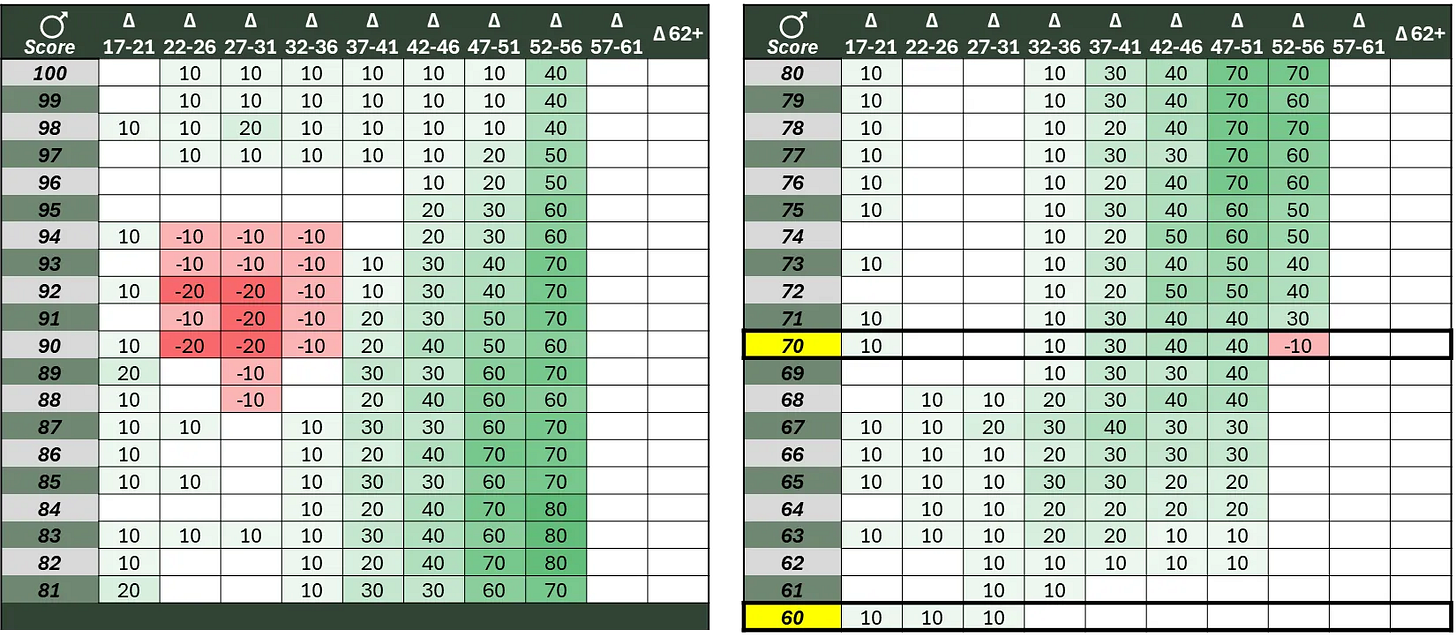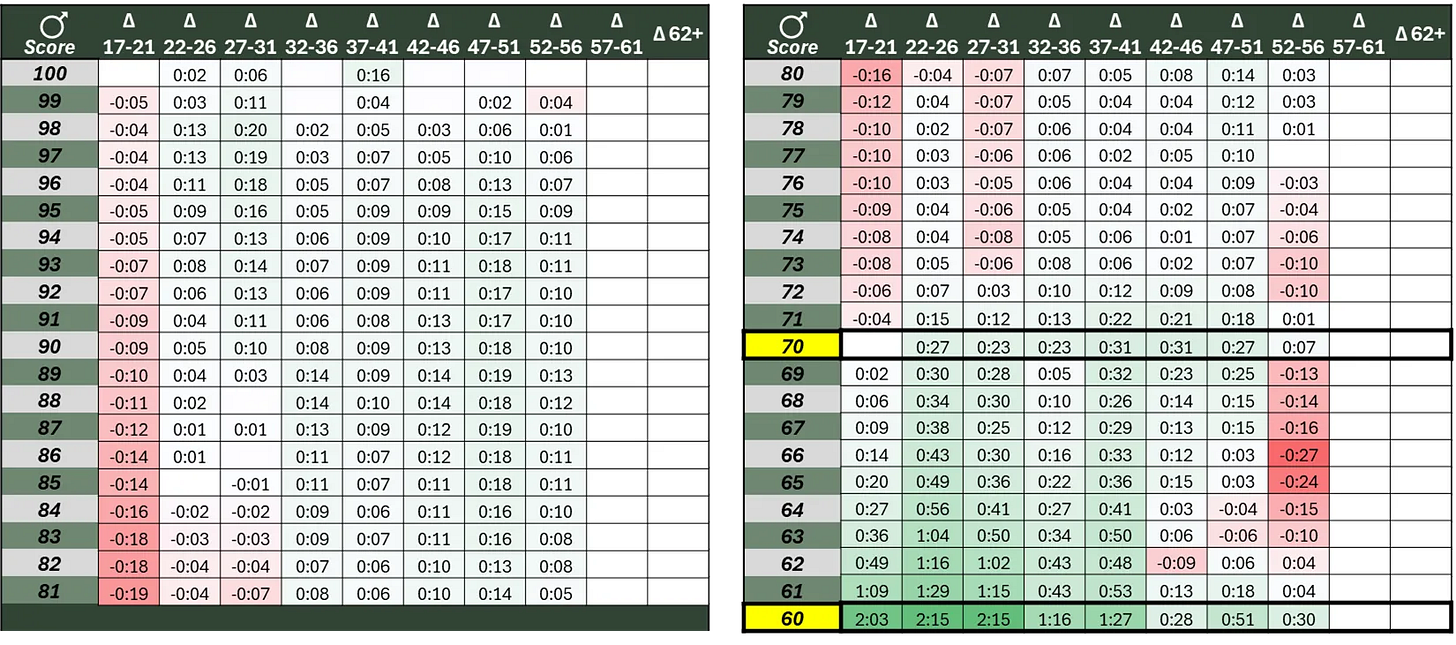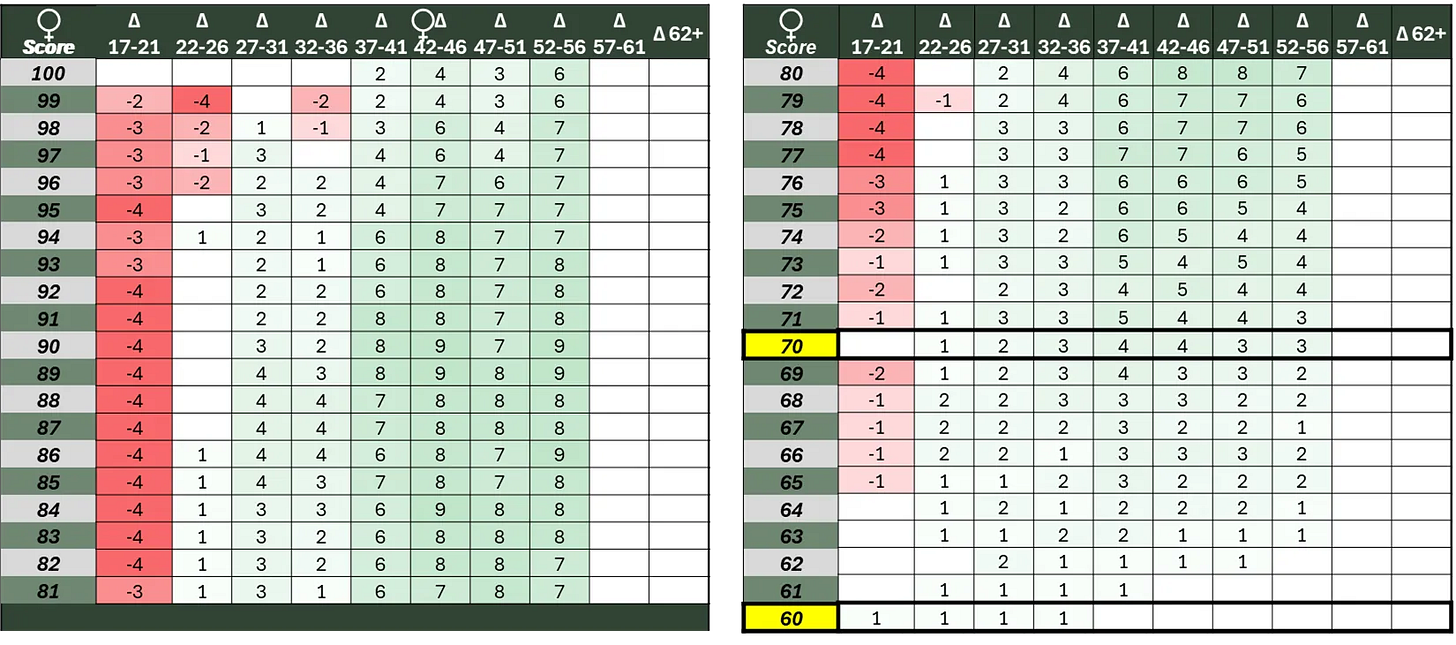Z.10a: AFT Deep Dive
Here’s the post for the real data nerds. For a quicker summary, check out the main post.
I’m going to examine the changes to each of the scoring brackets. Because this is a lot of data already, I’m only going to look at 60+ scores. For each of the events I’ll start with what changed for males, then females, and close with the changes to females in one of the 21 combat MOSs. Each chart will depict the raw score change. The numbers you see will be the change in pounds / reps / time you need to do just to keep the same points you had on your previous ACFT. The numbers are not the amount that needs to be lifted.
Because things get weird when you bounce between a deadlift that needs more weight, a sprint-drag-carry that requires less time, only to bounce back up to a plank that needs more time before coming back to run that needs you to go faster, we’re going to keep this simple.
Darker shades of green indicate a standard that got harder, while darker shades of red show where the standard gets easier.
The Deadlift

Males: The biggest changes came to the 37-56 crowd in combat MOSs. Scores over 70 for this age group saw the biggest increases, with some needing to pick up as much as an additional 80 pounds just to keep their points. Under 70 points the standards went up, though less so. Down at the minimum the scores only got 10 pounds heavier, and only for the younger age groups. However, if you are a male in a combat MOS and you only barely passed the deadlift before, you might be in for a challenge. You now need to pick up an additional 50 pounds to keep your job.
I haven’t seen an updated Army Directive 2023-08 to account for the five event AFT, but assuming the same rules still apply, then soldiers like me who want to skip the tape test will need to get a 450 overall with no less than 80 in each event — you need to average 90+ points, but if you only get 79 points in an event, you’re gonna get taped.
If that remains the case, while 17-21 guys saw their max score get at least 10 pounds heavier, getting to 90 points actually got easier for 22-36 year old males. 37 and up though, you’re going to need to deadlift as much as 70 pounds more to avoid the tape measure.
Gen-Pop Females: The changes to the females deadlift scale is more distributed. To keep their scores over 80 points just about every female is going to need to deadlift an additional 10 pounds, with some bumping up another 20. However, it’ll get 10 pounds easier to deadlift for those with passing scores under 80 points. There was no change to the minimum level for female non-combat MOSs.
Some of the staggered change is because of how the stepped scoring shifted. Since points are based off 10 pound increments, there is no way for a 20 year old female to score just 98 points, because 210 gets you 99 points. Several of the steps shifted slightly up or down, hence the noise in the table above. Overall, since these scale changes are likely based off six years of ACFT data, this is an overall good sign. It indicates more and more female soldiers are improving their deadlifts over their careers.
Combat Females: The changes for female deadlifts in combat MOSs is much more stark. Everything got heavier. To max the deadlift most female soldiers will need to lift over 150% of their previous max. If a combat MOS female was maxing her deadlift at the ACFT’s 240 cap, she’s now going to have to pick up as much as an additional 110 pounds to keep 100 points.
To pass at 70 points female soldiers now need to lift 190 pounds for three reps — except 17-21 year olds who have to pick up 200, and those 52 and over who only need to pick up 140. Based off the RAND study released last year, the highest concentration of females tested we already lifting this much. So while the number of points they score will go down, it looks like most females in combat arms MOSs are already meeting this standard.
The Hand-Release Push Up

Males: The new male minimum standard is higher for most soldiers, tapering off from five additional reps for the young 17-21s down to just one single additional rep for those near 52. Given the minimum passing standards are all still under 16, this should be incredibly achievable.
Maxing the HRPUs didn’t change much at all, just a single additional rep for 17-21 and 42-46. Keeping the 70 point minimum doesn’t require much more effort either. Only once soldiers reach 42 will they see a similar rise in standards as we did with the deadlift. A combat arms MOS male that was struggling to exceed the minimum 60 points will need to more than double their previous score.
Gen-Pop Females: HRPUs was one of two events in the old ACFT with gender neutral standards, the other being the plank. As such the new AFT scale for gen-pop females doesn’t move a lot. To pass, females need to do a single additional rep until they read 37. The impacts to scores is instead going to be felt most by females over 37 who were scoring more than 70 points. Many of these soldiers will need to do as many as nine more reps to keep their old score.
Combat Females: One of the unusual things on the female HRPU table is the way it drops off immediately, unlike the male scale which actually increases up to the 27-31 age group before slowly dropping back down. Only once males reach 52 do they have to complete noticeably fewer HRPUs reps to max than a 17-21 year old soldier. Meanwhile, female scores decline from age 22. This divergence means the delta for female in combat arms MOSs will grow as they age, having to do more and more push-ups. However, this mostly is only at the max end of the spectrum.
While both males and females will need to do as many as 18 more reps to meet the 70 point standard, combat arms soldiers still don’t even have to complete 30 total HRPUs. Most combat arms MOS females were probably already exceeding the old ACFT standard of 10.
Sprint Drag Carry
Males and Gen-Pop Females: There isn’t any point in posting the default male or female charts. The only change was a 52-56 year old male needs to run :01 seconds faster to still get 79 points. I do not know why. The gen-pop female standards did not change at all.

Combat Females: For the average combat MOS female under 52, they’ll need to run :36 seconds faster to keep their points. A half a minute is a lot of time to cut when you consider the scores cover a range from maxing with just 1:29 for 17-21 year olds to 3:42 for the minimum 60 points in the 42-26 age bracket. That’ll require shaving between a 40% and 16% off their time.
For many soldiers the sprint-drag-carry is the most taxing event. So, while most pundits will likely spill a lot of ink about the deadlift changes, I think these will be some of the harder ones to move. In my opinion, soldiers looking to improve their scores should focus on two areas. First, you’re going to want a certain amount of mass. While too much can hurt you, a 90 pound drag requires a 130 pound soldier to generate significantly more force than a 180 pound soldier. Second, you’re going to need to train your body to blow through your VO2Max and tap into your anaerobic tolerance. training regimens that focus on these, like tabatas and failure based METCONs are great places to start.
Max Boredom For Time (The Plank)
No change here. The standards were already gender neutral, and the AFT made no changes. So hunker down, count the blades of grass, ask your grader about their family, and find something to distract yourself from how much you wish we’d just do leg tucks instead.
Two Mile Run

Males: There are a few changes to the male run scale. First off, 17-21 year old males get a bit of an easier start. Just about all their times over 70 points got easier, on average by :10 seconds. Once they get less than 70 though, the run times start picking up speed, with noticeable jumps for the minimum 60 point standard. The youngest age bracket needs to run 2:03 faster just to pass.
We see a bit of the opposite on the older age brackets. Those 47 and older are where we see the biggest time cuts to scores over 70 — around :10-:15 seconds, while the boomer bracket gets a generally easier cutoff in the 70 point range.
The bare minimum run times for all males under 57 got faster, with those under 32 having to run a full two-minutes faster than the ACFT. Those who read my last post will not be surprised to hear I am very much a fan.
Gen-Pop Females: Some of the faster female run standards I lauded last week are getting scaled back, with most of the scale shifting about :30 seconds slower. This still leaves most female max run times faster than the ones they had under the old APFT. There is one weird anomaly in the 99-93 point range for women ages 22-31, where they have to run an average of :13 faster. Not sure exactly what’s driving the change there.
Similar to the males, across all age brackets women under 52 have to run just under :30 seconds faster to meet the minimum standard.
Combat Females: The impact to combat MOSs is again, much higher. Females in combat MOSs will have to run close to two-minutes faster to keep their points. Even more significantly, for any females who were previously passing at the ACFT’s 60 point standard, they’ll need to shave, on average, 4:31 to meet the new two-mile combat standard.
That’s reads like a big jump, but it’s not clear how many females will be impacted. Unfortunately, I don’t have data on the current average run times for females soldiers in combat MOSs. Many are likely already exceeding the woefully slow 60 point standards. Given that the new passing standard is between 18:23 and 21:00, a runner can pass the test while cruising along at just over a 9:00 pace.
For an easy to grab yardstick, I looked at the results for the recent Canberra Day 5k here back in March. 2/5ths of the females who ran the local fun run were able to hold that pace. These females didn't do the other four AFT events first, but they also ran another 1.2 miles, so it's not an unfair comparison sample.
These new standards are not insurmountable.
The AFT gen-pop minimums are very achievable and even the combat minimums aren’t anything that’d win you a medal at a high school track and field competition. But they are still a change, one we as leaders need help our soldiers make. We need to explain what changed, why, and we need to seek out new knowledge on how to best prepare our formations.
I’m going to beat this drum every day if I have to: Fitness is not just an NCO job. Readiness is a leaders job. We can do this. But we need all leaders, officers and NCOs to lead.
Welcome to the new fitness standard: ready. Everyone has 6 months to get ready. So go get yourself ready. Get your formations ready too. #AFTReady2025











